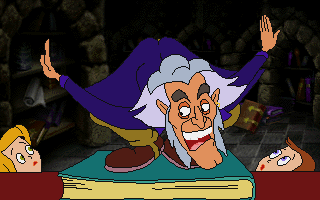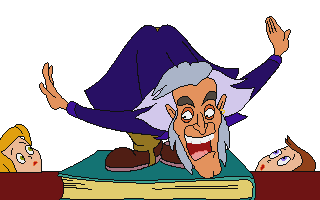Since I had nothing better to do, I decided to re-play some old adventure games and one of them was King’s Quest VII (I don’t know why it gets Roberta Williams name attached to it, she’s behind all previous KQ games as well, it’s Mask of Eternity and the 2015-2016 re-imagining that deserve Not Roberta Williams game title). And in my usual habit I also looked at intro/ending animations. As you all remember, there are DOS, Mac and Windows releases of the game and each of them uses its own format. Windows version uses 10-fps MS Video 1 in AVI, Mac version uses 8-fps Cinepak in MOV (with data in a separate resource fork as expected from Mac video), DOS version turned out to use 5-fps RBT. Thanks to Mike Melanson documenting it in the course of his experiment, I was able to write a quick and dirty program to unpack .rbt files (essentially it’s just raw frames compressed with LZStac so if you don’t care about handling errors or less common cases then 3.5kB program in C is enough).
And while doing that I remembered that animating of this game was partly done in-house but most of the work was outsourced to the various animation studios including the infamous Animation Magic. In case you forgot that is a studio with Russian origins that was mostly known for their unforgettable animation of CD-i games. Yes, those CD-i games. To their defence it mostly came from them being inexperienced with the computer animation and slowly the animations in their games became better at the expense of them becoming less memorable (animated fairy tales books are interesting only when Dingo Pictures does them!). But between MAH BOI games that are refusing to be forgotten and rather obscure Magic Tales series there were two edutainment first-person shooters, namely I.M. Meen and Chill Manor, that are still somewhat remembered by their wildly imaginative cutscenes. Of course somebody had to look at the format.
It turned out to be a custom format with intra-only RLE-packed video with the only interesting things about it being the use of up to 128 colours only, the fact it should be drawn over some external background (even the intro or ending), and that it uses run length 0 as “fill until the end of current line” mode. Audio is raw PCM, so nothing remarkable there.
For the comparison here’s the captured image from the intro playback (stolen from Mike’s review of the game):

and a decoded frame from intro.ani (not the same one but close enough):

You can find the missing background among the game files in PCX format though.
This is a bit crazy format but it was fun looking at it.